
views
Encouraging a Flying Bat to Leave

Protect yourself and your family. Bats are not aggressive animals and most survive off of eating insects. It is not common for a bat to attack a person, but like all wild animals there is a risk that the bat could be carrying rabies or another infectious disease. Wear thick gloves if you think you may come in contact with the bat or if you are going to attempt to catch it. Secure children and animals in a room the bat cannot access. Avoid direct contact with the bat if possible.
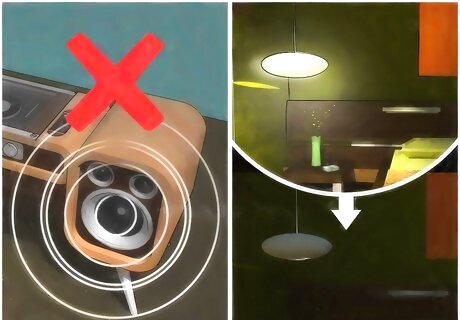
Corral the bat. Bats navigate using echolocation instead of sight, so the vast array of sounds in your house can make it difficult for the bat to find its way. Once the bat flies into a room with a window or door that has access the outside, seal off that room to prevent the bat from flying deeper into your house. Turn off the lights in the room and the exterior lights outside the door or window. Turn off any television, radio, or air conditioner near the exit that might make the bat avoid the area. Try to avoid making a lot of noises, as they will upset the bat and make it behave in less predictable ways.
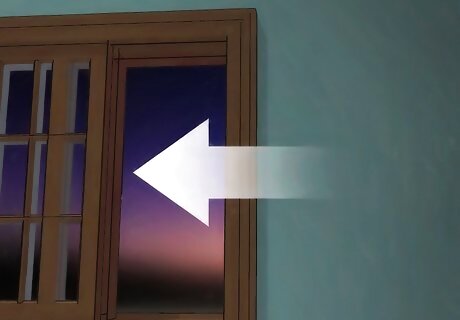
Open your doors and windows. Most bats do not want to be inside your house. They’re wild animals and prefer to stay in their natural habitat. The bat is probably looking for a way out, so providing it with an exit may solve your problem. Choose one exit that you intend to direct the bat to, but open other windows too in case the bat decides to fly out one of them instead. Use sheets with push pins to block off any doorways without doors into other rooms. EXPERT TIP Scott McCombe Scott McCombe Pest Control Specialist Scott McCombe is the CEO of Summit Environmental Solutions (SES), a family-owned local pest solutions, animal control, and home insulation company based in Northern Virginia. Founded in 1991, SES has an A+ rating with the Better Business Bureau and has been awarded “Top Rated Professional,” and “Elite Service Award" by HomeAdvisor. Scott McCombe Scott McCombe Pest Control Specialist Our Expert Agrees: When a bat enters a home, one easy solution is to isolate the bat to a specific room. Open any windows, and stuff a towel at the bottom of the door so there's not a gap the bat can use to escape. As long as the temperature outside is above 50°F, the bat should leave on its own.
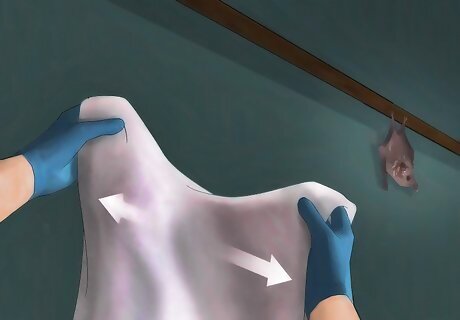
Narrow the bat’s flight area. Hold a sheet up at arm’s length to create a makeshift barrier or wall out of the sheet in front of you. If you can get a friend or family member to help this process will be easier. Move slowly toward the bat with the sheets up to limit its flying space and usher it toward the open exit. Position yourself and your friend in a way that makes flying in any direction other than the exit difficult. Keep closing in on the bat and the exit slowly until the bat has no choice but to fly out.
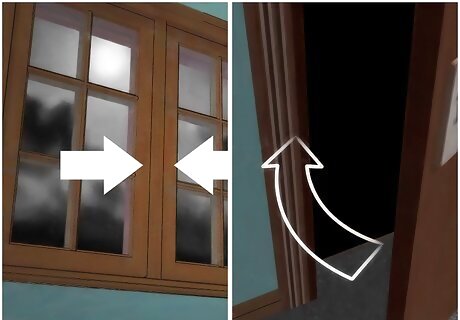
Secure the area once the bat leaves. Now that the bat has flown out of the house, close all entry points the bat may have used to enter your home. The bat is not likely to return, but if it is confused you run the risk of it returning. Close all doors and windows you opened to create an exit. Check the rest of the house for openings the bat may have used and seal them off. EXPERT TIP Scott McCombe Scott McCombe Pest Control Specialist Scott McCombe is the CEO of Summit Environmental Solutions (SES), a family-owned local pest solutions, animal control, and home insulation company based in Northern Virginia. Founded in 1991, SES has an A+ rating with the Better Business Bureau and has been awarded “Top Rated Professional,” and “Elite Service Award" by HomeAdvisor. Scott McCombe Scott McCombe Pest Control Specialist Consider calling a professional if you can't contain the bat. First, call animal control for free removal. If they're unsuccessful, call a local experienced wildlife control company to humanely remove the bat. This will be for a fee.
Catching and Releasing a Bat

Wait for the bat to land. Catching a moving bat can injure the bat and risk the bat biting or scratching you out of fear. Be patient and try not to make a lot of noise that scares the bat to encourage it to land. Catching a bat mid-flight can injure the bat or cause it to panic and attempt to bite you. Waiting for the bat to land provides you with the safest opportunity to catch it for both you and the bat.

Use a small box or bucket to catch the bat. Once a bat lands and is stationary, use a bucket, box or similar container to trap the bat. Find a container with a larger inside diameter than the bat is taking up in its stationary position to avoid injuring the bat by crushing a wing or ear. Approach the bat slowly and quietly then quickly place the container over the bat so that it cannot escape. Slide a piece of cardboard or container lid under the container slowly and gently to enclose the bat within the container and lid. Carry the container outside and release the bat back into your yard. While it is preferable that you release a bat after nightfall, you should not keep the bat contained until then if you catch one during the day.
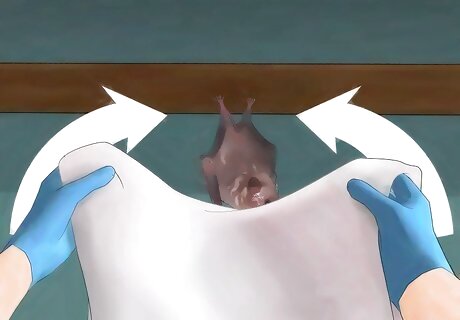
Catch the bat in a net or blanket. Another viable way to catch the bat is to use a decent sized cloth or net to capture the bat once it has landed. Depending on the thickness of the cloth or net, this method may involve more direct contact with the bat. Approach the bat slowly with the cloth or net in front of you. Place the net or cloth over the bat rapidly to avoid giving it an opportunity to fly away. The net may trap the bat immediately. If you are using a cloth towel or blanket, place it over the bat, then gently wrap the bat up with it. Carry the bat outdoors while still in the net or cloth, then release it. It is better for the bat if you release it after nightfall, but you should not keep the bat contained until evening if you capture it during the day. EXPERT TIP Scott McCombe Scott McCombe Pest Control Specialist Scott McCombe is the CEO of Summit Environmental Solutions (SES), a family-owned local pest solutions, animal control, and home insulation company based in Northern Virginia. Founded in 1991, SES has an A+ rating with the Better Business Bureau and has been awarded “Top Rated Professional,” and “Elite Service Award" by HomeAdvisor. Scott McCombe Scott McCombe Pest Control Specialist Check in an hour to see if the bat has left. If it hasn't, it may be sick, injured, or dehydrated. Immediately call local animal control or an animal rehabilitator to rescue the bat.
Removing Bats that Live in Your House
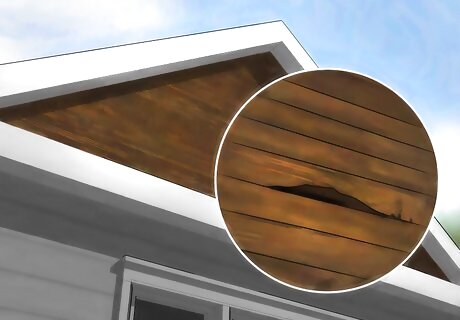
Inspect the situation. You will need to identify where the bats are getting in and out of your house in order to prevent them from returning once you have removed them. Bats often roost in attics, so look for gaps in the siding of your home, open windows or cracks. Many attics in older homes have gaps in the wood that are small enough for bats to crawl through, inspect the areas carefully as it takes very little space for a bat to get in. Make sure traditional openings like windows and grain doors in barns are closed securely.
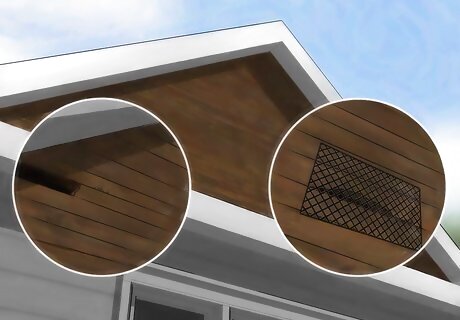
Seal off all but the main entrance and exit. Once you have identified the different places the bats have been accessing your house from, seal off all but one of them. Try to keep their “main” point of entry open. Determine the bat’s most highly trafficked point of entry by how much of the bat’s droppings you find in the area of the entry point. The other holes and gaps can be as small as a half inch and can easily be filled with caulk or sealed off with a piece of wood.
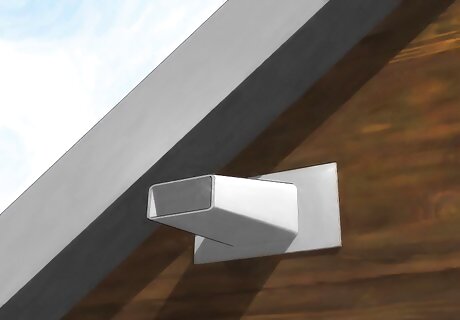
Set up a one-way exclusion device. Exclusion devices allow bats to exit your house in the evening just like normal, but prevents them from being able to come back in. There are a number of different types of exclusion devices you can make or that are available for purchase. Netting and screens can serve as exclusion devices if you position them in a way that makes it easy to crawl out of, but low enough that it would be difficult for a bat in flight to find the opening again. Funnels and “bat cones” narrow the entrance so significantly that it makes it difficult for bats to gain access to the funnel again while in flight. Exclusion devices can be bought at the store if you would rather not attempt to construct one yourself.
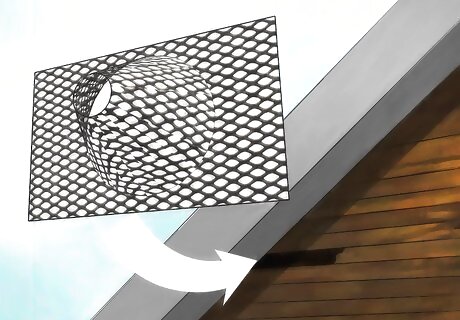
Make your own exclusion device. While you can purchase a variety of exclusion devices to help you remove the bats from your home, you can also create your own fairly easily with some screen and thumbtacks or a staple gun. Place the screen over the primary entrance and exit for the bats, with the screen flat against the side of your house but tented up a bit in the middle over the hole. Narrow the tented space in the screen down to a point about an inch wide at the bottom so the screen resembles a funnel from the top of the entrance to the narrow hole in the bottom. Bats will crawl out through the opening at the bottom of the screen, but be unable to grip and crawl back up to the entrance.
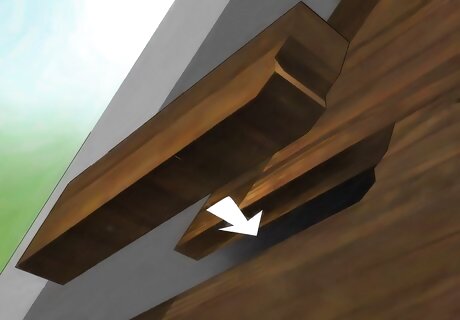
Seal off the exclusion device exit. After the bats are all out of your house, you will need to seal the main entrance that you had placed the exclusion device on to make sure no bats find their way back into your home. Bats have fairly long life spans and good memories, so they will attempt to re-enter your home if it is not properly sealed. Bats are not good at chewing or clawing through barriers, so as long as you seal the entrance they won’t likely be able to re-enter.

Clean up the area the bats resided in. Once the area is secure and the bats have vacated, you should make sure to clean up all bat droppings in your house. Bat droppings and urine can create issues for you and your family. Large amounts of bat droppings can cause wood to rot, compromising the integrity of your home. Bat droppings can lead to mold. Clean up bat droppings using a vacuum and all-purpose cleaner. Make sure to wash your hands when you are done.


















Comments
0 comment